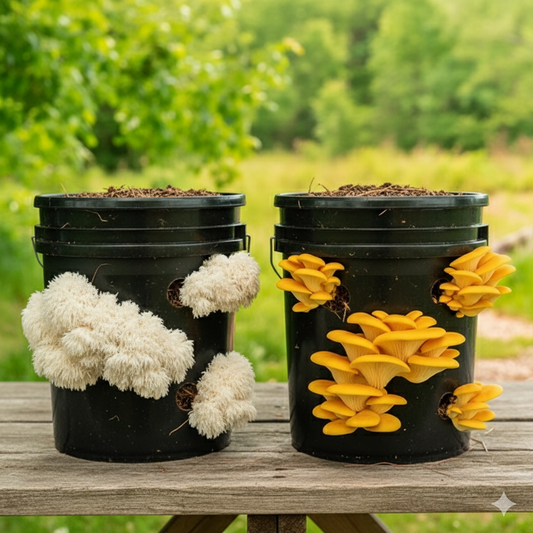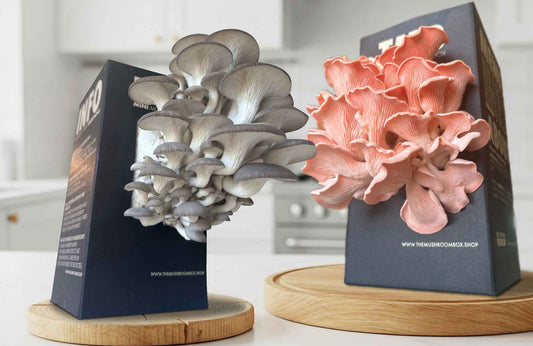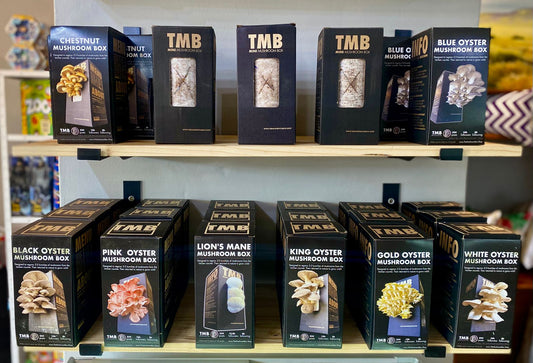
The Mushroom Bucket: Your Guide to Growing Abundant Gourmet Mushrooms at Home
Here at The Mushroom Box, our story began with a simple need for food security. When lockdown started in 2020, our founder, Alec, wanted a faster way to get food on the table than a veggie patch. He discovered that you could go from a tiny pinhead to a full mushroom harvest in a matter of days. This is the very same principle behind our mushroom bucket kits, which we now want to share with you.
Whether you're a seasoned gardener or just starting your journey into home cultivation, the bucket method is reliable, simple, and gives you consistent results—the very techniques that helped us grow from a passion project into a business.
What You'll Need
-
1 Pre-Drilled, Food-Grade Bucket: This is your primary growing vessel, with perfectly sized holes for ideal mushroom growth and airflow.
-
1 Bag of Chopped Straw: The perfect food source for your fungi, shredded to the ideal size for rapid colonization.
-
1 Bag of Premium Mushroom Grain Spawn (the substrate inside the Mushroom Box will do): This is the heart of your bucket farm. We've recommend vigorous, fast-growing varieties like Pink Oyster, Blue Oyster, and gold Oyster, so you can count on a delicious and plentiful harvest.
-
1 Burlap Sack & Bungee Cord (Or an old pillow case): For preparing & draining your straw and keeping it secure.
How to Set Up Your Mushroom Bucket
This method simplifies the entire cultivation process. All you'll need is a large stock pot for pasteurising your straw.
Prep Your Straw
Mushrooms thrive on clean organic material, so we first need to prepare the straw by pasteurising it. This process reduces competing moulds and bacteria, giving your fungi the best possible start.
Method 1: Hot Water Pasteurization

-
Stuff all the chopped straw into the burlap sack and tie it closed.
-
Place the sack into a large, clean pot (at least 16-litres). Place a weight on top to keep the sack submerged.
-
Fill the pot with water until the straw is fully covered.
-
Heat the water to around 82°C and maintain a low simmer for one hour.
-
Turn off the heat, carefully remove the weight, and very carefully lift the hot sack out of the pot.
-
Hang the bag to drain and cool for at least two hours (or overnight). The straw should feel moist, but you should only be able to squeeze out a drop or two of water.
Method 2: High pH Cold Water Pasteurization
Expert Tip: This method is great for a full-proof pasteurisation and ensures you get the best yield out of your kit
-
Stuff the straw into the burlap sack and tie it shut.
-
Choose a vessel (like a 16-litre pot) large enough to submerge the straw.
-
Fill the container with enough clean, cold water to fully cover the straw.
-
Slowly add hydrated lime to the water, stirring as you go, until the pH reaches approximately 12.5 (a pH meter is needed for this).
-
Submerge the straw-filled burlap bag, weighing it down with a clean rock or similar weight.
-
Let the straw soak for at least 12 hours.
-
Remove the bag from the water and hang it to drip dry for 12 to 24 hours until the straw is just moist.
How to Inoculate Your Bucket
Once your pasteurised straw has cooled to the right moisture level, it’s time to introduce the mushroom spawn:
-
Thoroughly clean and sanitize your bucket using warm water and soap.
-
Break up the grain spawn (Substrate in your mushroom box) by kneading the bag, then cut it open.
-
Begin filling the bucket with alternating layers: start with a layer of pasteurised straw at the bottom (about 3-5 cm thick), then sprinkle a small portion of the mycelium spawn over it.
-
Repeat these layers until the bucket is full. Don't compress the straw too tightly; a little air is good for the mycelium!
-
Once full, cap the bucket.
Colonization

Now the magic happens!
-
Place your bucket out of direct sunlight, somewhere cool and dark (between 15°C and 24°C).
-
Over the next 10-21 days, the mycelium will colonize the straw. It often generates warmth, so make sure there is proper airflow if you're stacking multiple buckets. A sweet, anise-like smell is a great sign of healthy oyster mushroom mycelium!
-
Success is signalled by the appearance of "pins"—tiny mushroom clusters poking through the pre-drilled holes.
Fruiting

Once pinning begins, your mushrooms need the right environment to mature.
-
Find a well-shaded, low-wind spot. Outdoors or indoors will work great, but a protected balcony, deck corner, or open shed will work well.
-
Crucially, keep the pins from drying out! Mist them a few times daily, especially if the air is dry.
-
Your mushrooms can be ready for harvest in less than ten days after pinning. Optimal fruiting for most oysters occurs between 10°C and 27°C.
South African Seasonality
South Africa’s diverse climate means you can grow mushrooms almost all year round if you know how to adapt.
-
Spring & Autumn (Ideal): These are your perfect growing seasons. The moderate temperatures and natural humidity across much of the country create the ideal conditions for oyster mushrooms to thrive outdoors.
-
Summer (Warm-Weather Strains): For the hot summer months, especially in inland areas like Gauteng or the Karoo, we recommend growing warmer-weather strains like Pink Oysters. For other varieties, prioritize deep shade and mist more frequently. If temperatures get extreme, consider moving your bucket to a cool, dark spot indoors.
-
Winter (Coastal & Inland): In warmer coastal areas like Cape Town, winter is an ideal time to grow. In colder inland regions, outdoor fruiting will pause, but your mycelium can survive the cold and re-emerge for new flushes in the spring.
Harvesting
Harvest your mushrooms just as the caps begin to curl upwards, before they release their spores. Harvest whole clusters by slicing them clean against the bucket with a sharp knife.
-
Cook them right away, or store them in a paper bag in the fridge for up to a week.
-
Don't throw out your bucket! You can expect 2-4 flushes from a single kit.
Beyond the Bucket: Starting Your Outdoor Patch

The journey doesn't have to end with your final harvest. You can give your spent substrate a new purpose and potentially get more mushrooms for seasons to come.
Once your bucket is done producing, simply break up the spent straw and spread it on the ground near a tree stump or a decaying log. With a bit of luck, the mycelium will grow deep into the roots of the stump, colonizing the wood and creating a thriving outdoor mushroom patch.
This is a great way to continue your connection to nature and get a surprise abundance of mushrooms when you least expect it. Enjoy your harvest, and when you're ready for more, you can grab a refill kit and start all over again!
No comments






0 comments